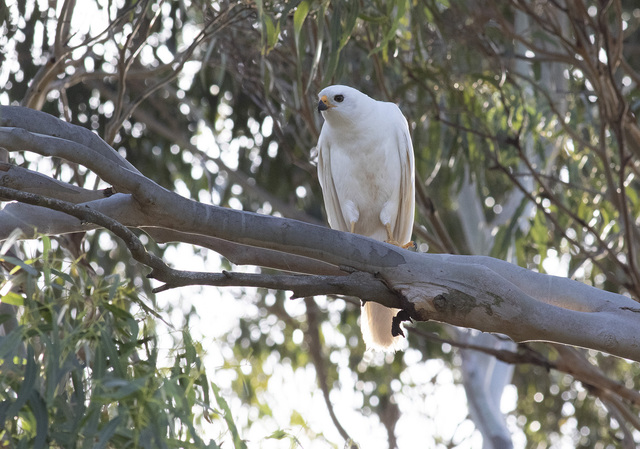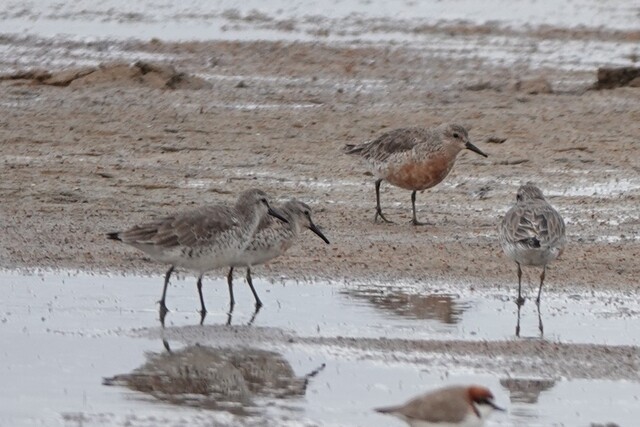The weather has been very fresh and cold over the past few weeks, but despite the wintery conditions there have been a few interesting bird observations around the Bellarine Peninsula.
Thanks to my friend Pete Sullivan, I saw a flock of migratory shorebirds known as red knots at Freshwater Lake, near Point Lonsdale.
These shorebirds are ‘near threatened’ in conservation status. They nest at this time of the year in the Arctic Circle around Canada and Russia, but Pete saw a flock of around 55 of these birds that have chosen to ‘overwinter’ or remain in the southern hemisphere for our winter and avoid the long flight to breeding grounds.
Interestingly one of the birds in Pete’s photo is moulting into the reddish breeding plumage that these birds develop at breeding time. The birds that remain in the Southern Hemisphere at breeding time are apparently usually those that are young and not yet ready to breed.
Freshwater Lake is a haven for shorebirds at the moment as it is not full of water, which leaves a great amount of muddy shoreline for waders to use to feed on insects and crustaceans. Some other species also present at the lake are red-necked Stints, which are also overwintering in Australia rather than flying to the Northern Hemisphere to breed, and non-migratory waders such as hooded plovers and red-capped plovers.
The last two species are sedentary in that they live and breed in Australia rather than flying across the world to different hemispheres.
Hooded plovers flock in the winter time and then disperse to breeding habitats in spring and summer, and at last count there were 37 hooded plovers enjoying the delights of Freshwater Lake.
This indicates that the birds have travelled to this area from the Surf Coast and even from as far as Phillip Island to gather for the winter. It’s amazing that Freshwater Lake is sustaining such numbers of shorebirds currently.
I had a quick visit to the lake to check the birds out, and while walking down Clowes Road I saw a big white bird take off from the ground and perch is a gum tree. I thought it was a sulphur-crested cockatoo, but unlike these birds it was silent, so I actually scaled a fence to check the bird out and I was thrilled to see a white morph grey goshawk and it hung around briefly for a photo which was great.
I received an email from Karen, who stopped at Lake Lorne on her way home from Drysdale to Ocean Grove. She entered from Reserve Road and saw plenty of ducks on the lake, but couldn’t get a picture with her iPhone as they were too far away, so grabbed her binoculars from the her car, and identified the ducks as pink-eared ducks, which she aptly described as “such beautiful birds their markings and bills are extraordinary”. Pink-eared Ducks are highly mobile birds that fly great distances in search of water, with large flocks often reaching coastal areas in dry years.
I received an email from Lynne, who has noticed I have seen black kites regularly at Drysdale.
She has been taking her dogs to Pawsome fenced paddock in Drakes Road for a run two or three times a week for the past year and nearly always there has been a black kite or two next door at the Drakes Bushland Reserve.
One day earlier in the year there were five of them together. If they are not in the reserve trees or the dead tree they are flying over the surrounding paddocks and sometimes she also sees a little eagle. At the moment the reserve is full of rabbits which is attracting the raptors no doubt.
Lynne has been enjoying all the birds that visit my garden daily and some which have been coming occasionally. Currently an eastern spinebill is visiting daily.
Recently a flock of yellow-tailed black cockatoos were feeding off the hakea next door. Currently the musk lorikeets are also coming late afternoon to the flowers in the big ash tree.
A cockatoo has been dropping in occasionally, but in the warmer months dropped in every day for a drink and to eat the apricot kernels. The pair of magpie-larks and eastern rosellas are in Lynne’s garden every day and have been for years, enjoying the lawn and the birdbath.
Sometimes Lynne finds the magpie-lark very casually walking around in the kitchen or dining room if the back door is open for the dogs. The birds are very comfortable and happy at Lynne’s place, despite the dogs.








